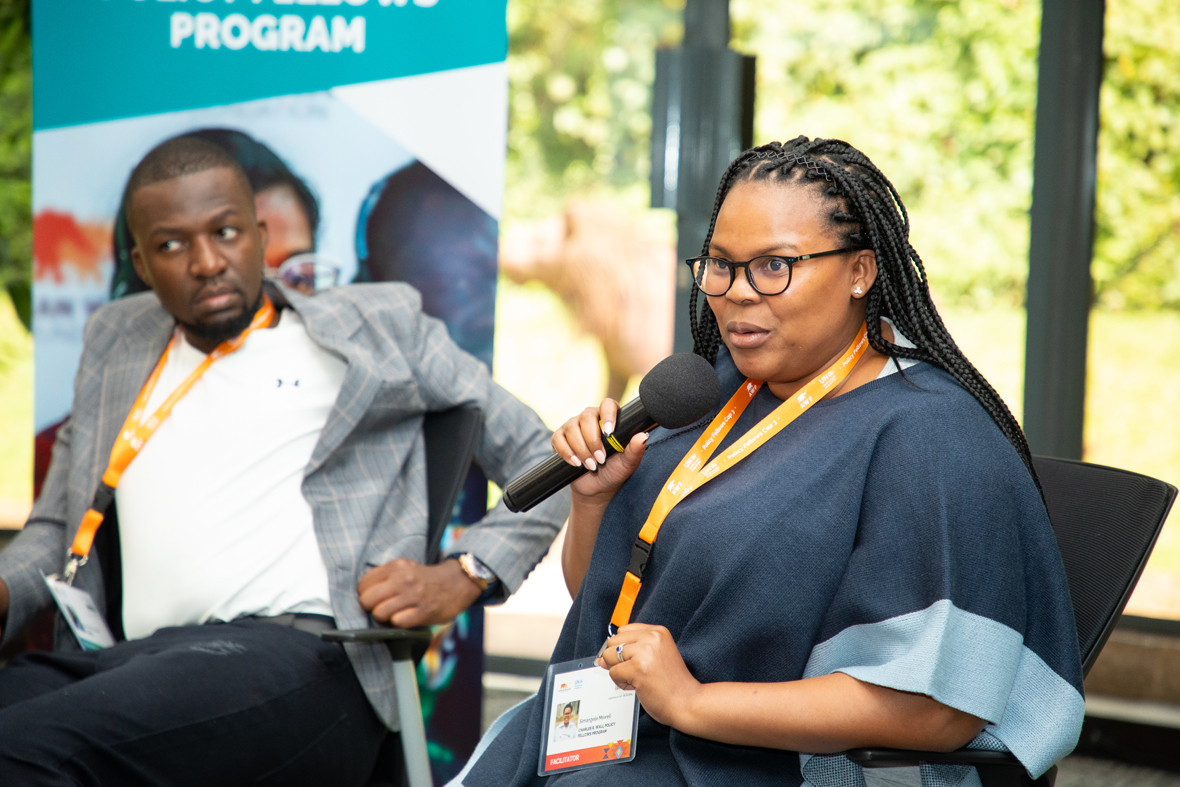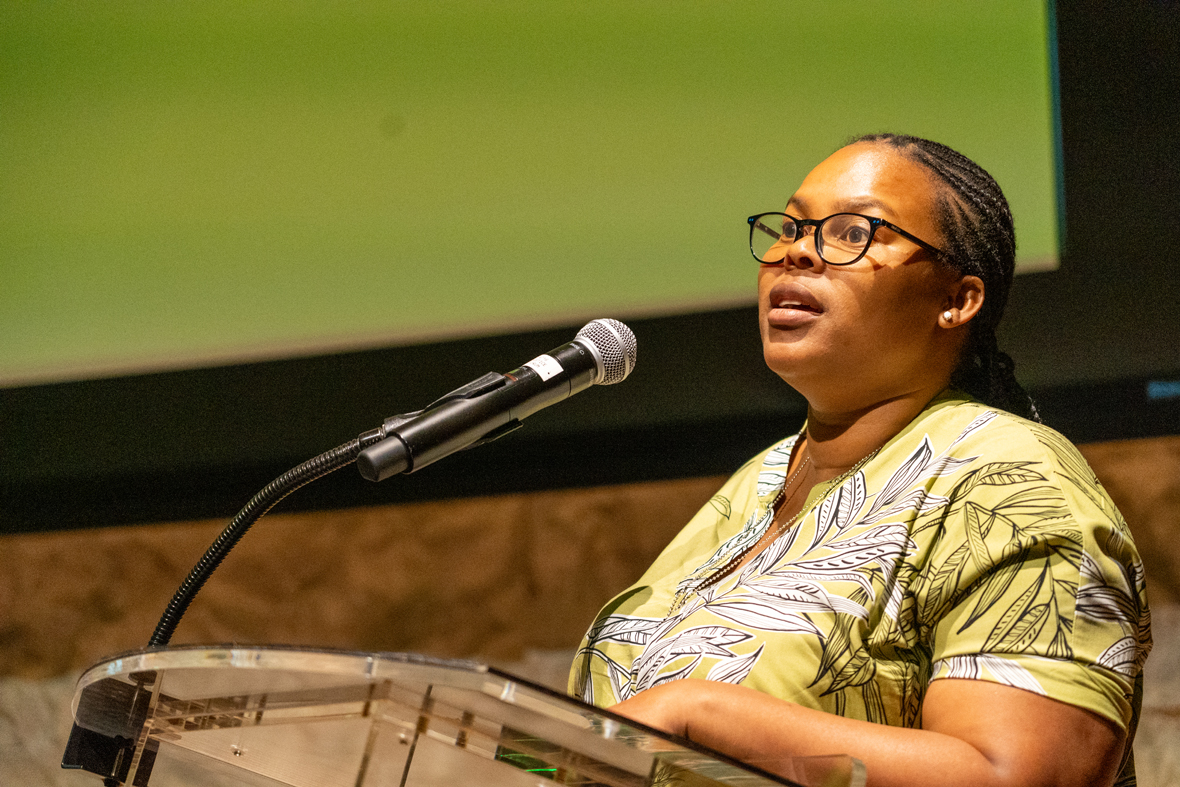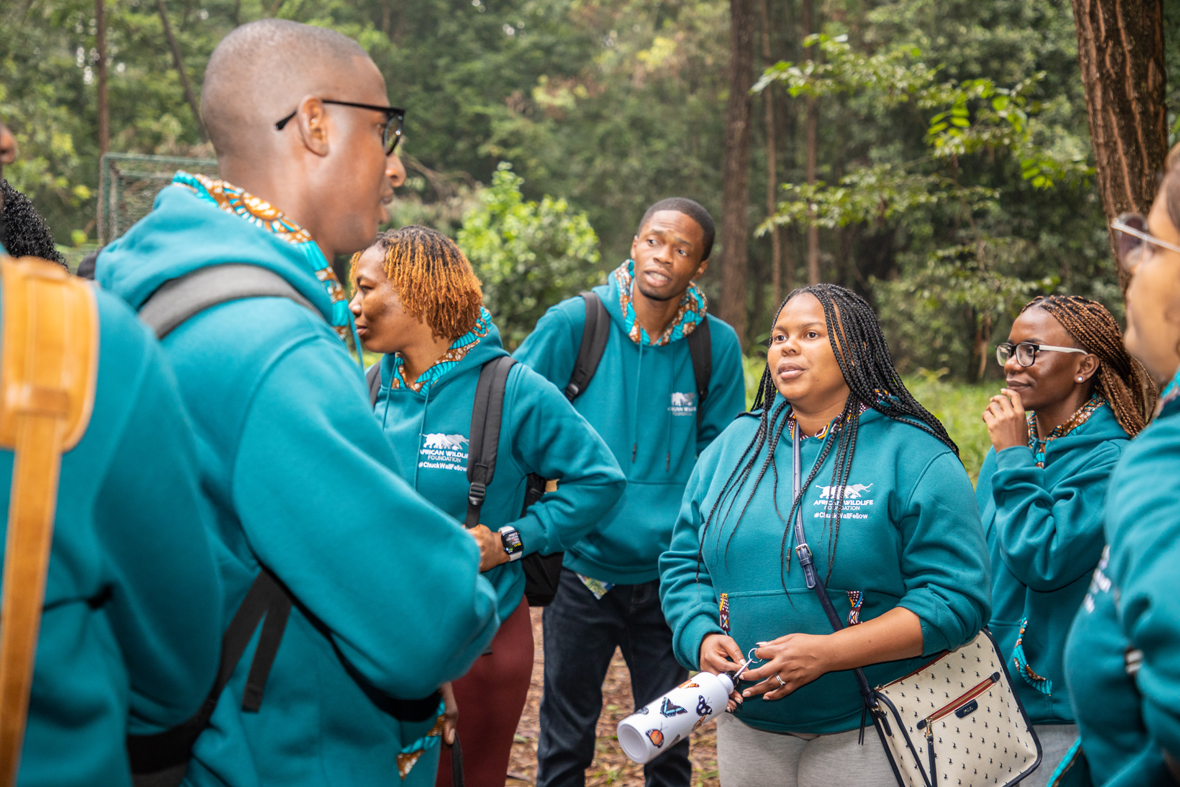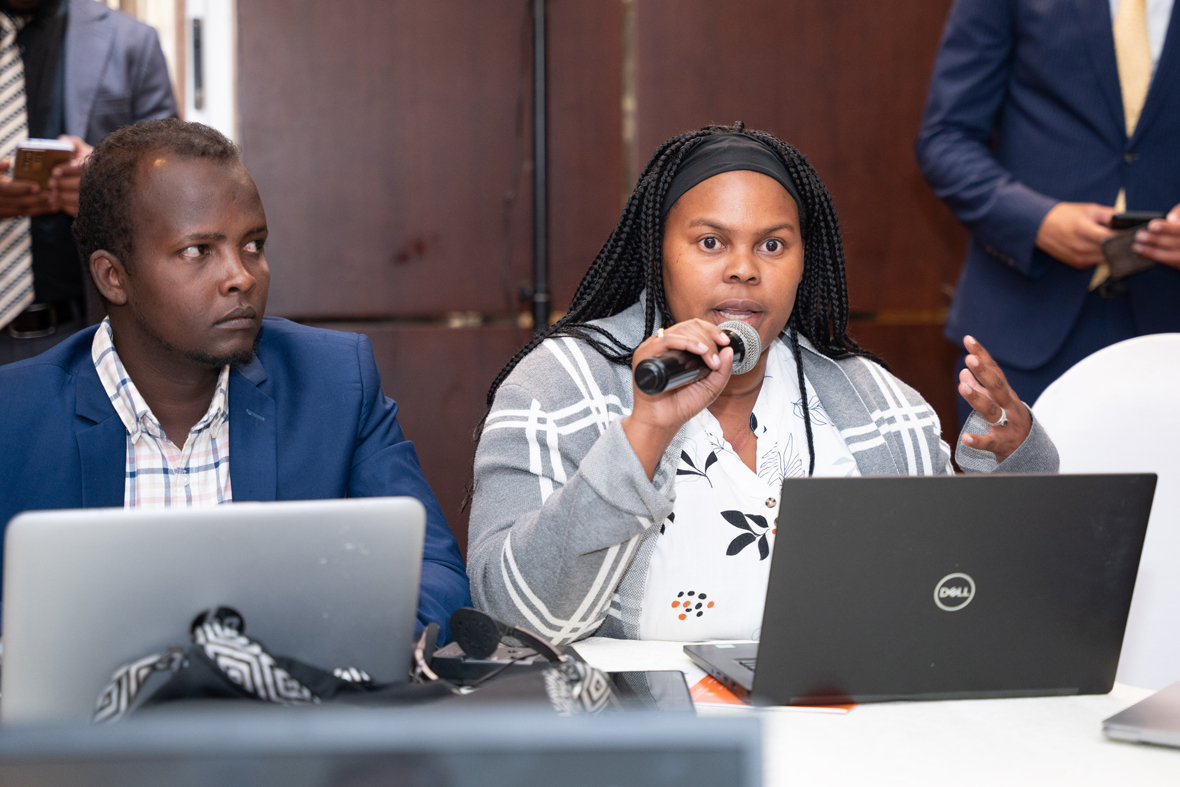Engaging Africa’s Youth: AWF’s Mission to Make Conservation Matter

Simangele Msweli during one of the youth Workshops
Since its inception, the African Wildlife Foundation (AWF) has deliberately worked towards fostering the best and brightest minds to lead conservation in Africa. Through collaboration with various partners, AWF trains future conservationists and change agents by engaging the youth in conservation learning and advocacy and mobilizing them to demand meaningful conservation action.
All these efforts help create new generations of young people who use their talent and creativity to protect Africa’s wildlife and essential ecosystems. This emphasis on supporting youth leadership has never been more important—the average age across the African continent is 19, with more than three-quarters of the African population under the age of 35.
This majority cohort needs the capacity and opportunities to take up conservation leadership positions, especially as African countries grow economically and work toward sustainable development goals. AWF nurtures this ambition through programs that build leadership in law enforcement, wildlife management, research, media, and the conservation sector.
Complementary to this is a conservation education program aimed at primary and secondary school-going children, designed to inspire a new generation of Africans who understand the value of conservation in their lives.
Simangele Msweli is AWF’s senior manager of AWF’s formal youth fellowships, the AWF-Wall Leadership & Management Fellows and the AWF-Wall Policy Fellows. She also runs our Young Conservation Heroes programming with schools and wildlife clubs. This is her story.
You came to conservation as a youth yourself. What is your origin story?
I’m not your typical conservationist. I don’t have a background in environmental science or conservation biology. In fact, I joined AWF as a learning and development practitioner.
But if I’m being honest, I’ve always been a bit of a tree hugger. I cared about the planet, did the responsible things, recycled, composted, joined the occasional advocacy campaign, but I never thought that would lead me to a career in conservation.
I studied law, but pretty early on, I knew I wasn’t going to be a practicing lawyer. Right after university, I joined a volunteer program through Voluntary Service Overseas (VSO), and that’s where things shifted for me. The International Citizen Service program had three core outcomes: personal development, active citizenship, and strengthened communities. That experience made it clear that I wanted to work in a space where I could help people and organizations achieve exactly that.
Later, I worked with other institutions that nurtured and encouraged my passion for youth. I saw a vacancy at AWF for a Senior Youth Officer. They weren’t looking for a biologist, they were looking for someone who could design leadership programs for young professionals in conservation. That was my lane.
I joined, and since 2022, I’ve been leading the AWF-Wall Youth Leadership Program, which now has 108 fellows from 31 countries across Africa. Looking back, I realize you don’t have to be a scientist to make a difference in conservation. You need passion, the right skills, and the willingness to show up.

Simangele Msweli during a presentation
Why is AWF so focused on African Youth?
AWF is all about protecting Africa’s wildlife and wild lands, not just for today, but for generations to come. But we’re not doing this in a vacuum. Imagine trying to protect a forest that hosts your elephants but sits right where someone wants to build a road, a farm, or a housing estate. Most of our wild spaces are on land developers would call “prime.” And with Africa’s population growing fast, the pressure on these habitats is only going to get worse. Now, ask yourself this: Who’s making the decisions about how that land gets used? Who’s shaping the future of development on this continent? That’s where youth come in.
Over 70% of Africa’s population is under 35. That means in a lineup of 10 people, 7 of them are young. Meanwhile, the average age of an African leader is somewhere around 61, while the average African is just 19. That’s a massive gap. But also, a massive opportunity.
If we want to secure Africa’s biodiversity, we can’t just hope the next generation picks it up by osmosis. We have to be intentional. We need young people who don’t just see nature as something “out there” but as something deeply connected to their own futures. We need them to see forests, rivers, and wildlife as assets, not obstacles to development. Because the truth is, it is people who decide to clear a forest, poach a species, or pollute a river. But people also have the power to protect and restore. That’s why AWF is all in on youth. Not because it's a buzzword. But because it’s smart. It’s necessary.
If we can help shape a generation that sees conservation not as a side project but as a core part of development, then we’ve got a shot at real, lasting impact. Even after institutions like ours are long gone. Conservation only works when people are at the center of it. And in Africa, that means putting youth at the center too.
What do youth care about? Do you see differences based on age groupings or other demographics?
Young people aren’t all the same. “Youth” covers a huge range of experiences. Sure, they might fall into the same age bracket, but that doesn’t mean they think, live, or see the world the same way.
Some grew up in cities, some in rural areas. Some have access to education and resources, others don’t. Culture, gender, income, and all of that shape what they care about.
That said, there are some things we do see across the board. Most young people are in a transition phase. They’re moving from being taken care of to taking care of themselves and others. They’re starting to make their own decisions, build their identity, and find their voice in society.
It’s a time when many start asking: How do I want the world to look, and what role can I play in shaping it? And that’s the key, youth want to participate. They want to be involved in real conversations about real issues. Whether it’s jobs, climate change, inequality, or education, they’re paying attention. They care, not just because these things affect them now, but because they know they’ll be the ones dealing with the consequences in the long run.
How does conservation connect to their lives?
Many people think conservation is about forests, animals, or national parks. But it’s much closer than that. Think about where your food comes from. The water you drink. The air you breathe. Or even the climate crisis that’s affecting everything from your job prospects to your cost of living. That’s all conservation. If your local river dries up, that affects farmers. If trees are cleared for poor development, your neighborhood becomes hotter and more flood-prone. If ecosystems collapse, so do the economic outcomes built around them.
For young people, conservation is tied directly to their future, whether they live in cities or rural areas. It’s not a luxury issue, it’s a survival issue. Whether you're a farmer, tech innovator, policymaker, or artist, your world is shaped by the state of your environment.
And let’s not forget, Africa’s biodiversity is one of our biggest natural assets. If young people don’t get involved in shaping how we protect and use it, someone else will, often without us in mind. So in short: conservation isn’t something separate from their lives, it is their lives.
What is one misconception people bring to the table when they think about Africa’s “youth?”
One of the biggest is this: young people are seen as a “target group,” not as contributors. In most international development spaces, and even within our own systems in Africa, youth are treated as recipients. People to be “helped.” Rarely as equal partners or agents of change.
I come from a culture that’s deeply ageist. Respect for elders is central in many African communities, and while that has value, it often comes at the expense of youth participation. In many African languages, the way we speak about young people reflects this power imbalance, they’re seen as impulsive, lacking wisdom, and not yet ready to lead. There’s a popular saying in many communities: “What an elder sees while sitting, a young person cannot see even if they climb a tree.” It sounds wise, but it also reinforces the idea that young people’s ideas and perspectives are inherently limited.
You see this mindset in how institutions treat youth-led initiatives. When funding is available, it’s usually for small, short-term activities, like planting trees, organizing cleanups, or handing out branded t-shirts. Rarely are youth-led groups trusted with long-term investment. The assumption is: they’re not ready, they can’t handle it. But that’s not true.
We’ve seen countless examples of youth organizations delivering impactful, scalable work, when given the chance. Another common misconception is that young people are just “dreamers,” full of wild, creative ideas that aren’t grounded in reality. So they’re often brought in for symbolic participation or kept in side events, but not trusted to join member state delegations as experts, advisors, and negotiators. We see this play out in global policy spaces all the time, like MEAs (Multilateral Environmental Agreements), where youth are allowed to attend, even speak, but rarely included in official delegations where real decisions are made.
There’s also a belief that young people don’t understand complexity, that they can’t think long-term or grasp policy or governance. That’s simply false. Many young Africans today are incredibly well-informed, strategic, and solution-oriented. What they lack isn’t ability, it’s access and trust. Until we shift from seeing youth as a group to be managed to a generation ready to lead, we’ll keep missing out on the energy, insight, and innovation they bring. They’re not just the future, they’re already doing the work. The question is whether the rest of us are ready to move out of the way and let them lead.

Simangele Msweli with one of the AWF Wall Youth Leadership program cohorts during a field trip
What are you most excited about right now?
Right now, there’s a lot to be excited about. At AWF, our youth work sits on three main pillars: leadership, networks, and opportunities. That means we’re not just training young people, we’re helping them grow into leaders, strengthening the youth organizations they’re part of, and connecting them to real opportunities in things like entrepreneurship and conservation careers.
On the leadership side, one of the things we’re super proud of is the AWF-Wall Youth Leadership Program. It's in its fourth year now, and we’ve got 108 fellows from 31 African countries. That’s 108 young professionals being trained to lead with a conservation mindset, whether it’s in policy or management.
And the big news? We've secured funding to run the program until 2029. Even better, we’re expanding it! We're building an online version so we can reach way more youth beyond the 30 we take in annually. The online track is going to open the door for anyone interested in environmental governance and leadership to learn and grow, wherever they are. That’s huge for us, it’s about scaling our impact in a real way.
We’re also launching an exciting new project in Rwanda that focuses on engaging youth in climate resilience work. It’s funded by the EU and really shows how local, grassroots action can look when young people are at the center of it. It ties back perfectly to what I’ve been saying all along: young people aren't just the future, they’re active players now.
Can you tell me a story that demonstrates how the fellowships you run are impactful?
There are so many stories we could share, but let me tell you about Joanna from Namibia. She was part of our 2023 AWF-Wall Leadership and Management Fellowship and worked at the Environmental Investment Fund of Namibia, a key national institution that supports environmental projects through grants, loans, and sponsorships.
Joanna was in charge of managing community grant processes, but the system had a serious bottleneck. From the time a community organization applied for funding to when they actually received it, the process could take up to six months. And that’s a long wait for communities trying to respond to urgent environmental challenges.
As part of the fellowship, every participant takes on a real-world innovation project at their workplace. Joanna chose to tackle this exact problem. Using problem-solving tools and frameworks, we teach in the organizational leadership module, like systems thinking and design thinking. She talked to everyone: beneficiaries, colleagues, even other organizations with similar grant systems. She mapped out the pain points, tested new ideas, and eventually prototyped a streamlined process.
The result? She cut that six-month timeline in half. Three months from application to funding. That’s not just a technical improvement, that’s lives changed. That’s environmental projects getting off the ground faster, and communities seeing impact sooner.
Her former organization was so proud that they actually featured her work on their website. Stories like Joanna’s remind us that this isn’t just about training for the sake of it. When young professionals are equipped with the right tools, support, and belief in their potential, they go back into their spaces and improve things. That’s the kind of leadership Africa needs.
What do we mean by the “multiplier effect”?
It’s pretty simple, really. When we train one young person through our fellowship or other programs, we’re not just investing in them, we’re investing in everyone they’ll go on to influence. The idea is that they take the skills, knowledge, and mindset they’ve gained, and multiply that impact in their own communities. We’ve seen fellows start their own initiatives, run workshops, influence policy, or build projects that bring even more young people and community members into conservation spaces. So instead of us reaching 30 fellows a year, for example, those 30 might each reach 100 more. That’s the multiplier effect, creating a ripple of conservation leadership that keeps growing far beyond the original program. And that’s how real change happens. One inspired leader becomes many.

Simangele Msweli during a presentation
What is the biggest hurdle young African conservationists face?
Honestly, it’s not a lack of passion or good ideas; it’s what happens after. Young African conservationists are often left out of real decision-making. They can bring evidence-based, practical solutions to the table, but those solutions rarely make it into actual policy or development plans. That’s frustrating. On top of that, they struggle to access funding, mentorship, or platforms to implement their ideas. And in many cases, when youth are included, it’s tokenistic; they’re invited to listen, not to shape the agenda. So the biggest hurdle? It’s a mix of being excluded, unsupported, and constantly disappointed by systems that don’t walk the talk.
Explore how we are creating opportunities for youth in the latest issue of Resilient Africa